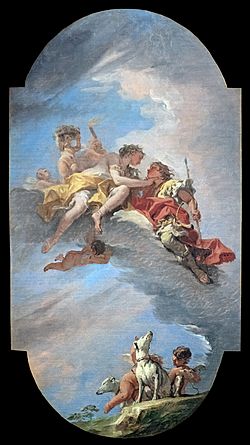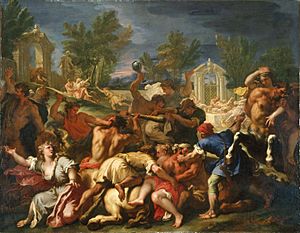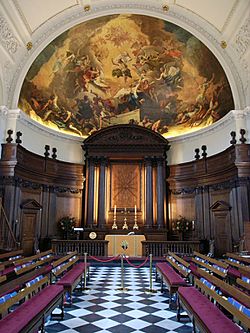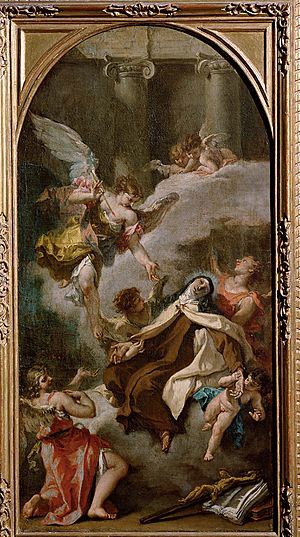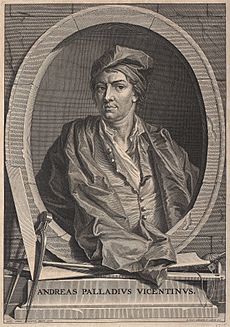Sebastiano Ricci facts for kids
Sebastiano Ricci (born August 1, 1659 – died May 15, 1734) was a famous Italian painter. He belonged to the late Baroque art movement in Venice. Ricci was known for his bright and lively fresco paintings, which were large wall or ceiling artworks. He was a bit older than another famous painter, Piazzetta, and lived at the same time as Tiepolo. Ricci's art showed a later style of the strong and colorful painting that was popular back then.
Quick facts for kids
Sebastiano Ricci
|
|
|---|---|
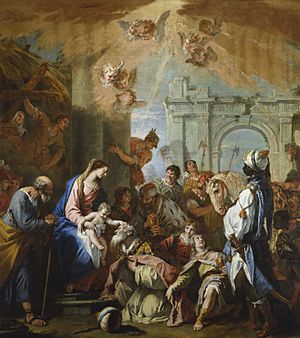
The Adoration of the Kings, 1726 (Royal Collection)
|
|
| Born | 1 August 1659 |
| Died | 15 May 1734 (aged 74) Venice, Italy
|
| Nationality | Italian |
| Occupation | Painter |
| Spouse(s) | Unidentified wife (m. 1691) |
| Children | 1 |
| Family | Marco Ricci (nephew) |
Sebastiano Ricci was the uncle of Marco Ricci (1676 – 1730). Marco also trained as a painter with Sebastiano. He later became well-known for his new ideas in landscape painting.
Contents
Early Life and Training
Sebastiano Ricci was born in Belluno, Italy. His parents were Andreana and Livio Ricci. In 1671, when he was young, he became an apprentice to Federico Cervelli in Venice. An apprentice learns a skill from a master. Some people believe that Ricci's first teacher was Sebastiano Mazzoni.
In 1678, Ricci faced some trouble in his personal life. He was put in prison but was later set free with help from a nobleman. He eventually married the mother of his child in 1691.
After being released, he moved to Bologna. There, his painting style was influenced by another artist, Giovanni Gioseffo dal Sole. In 1682, he was hired to paint a work called Decapitation of John the Baptist.
In 1685, a nobleman from San Secondo hired Ricci. He was asked to decorate the Oratorio della Beata Vergine del Serraglio. Ricci finished this work in 1687, working with Ferdinando Galli-Bibiena. In 1686, Duke Ranuccio II Farnese of Parma asked him to paint a Pietà. This painting was for a new Capuchin convent. From 1687 to 1688, Ricci also decorated rooms for the Duchess in Piacenza. These paintings showed scenes from the life of Pope Paul III.
Travels to Turin and Return to Venice
Around 1688, Ricci left Bologna and went to Turin. He faced more legal problems there and was again imprisoned. However, the Duke of Parma helped him get free. The Duke then hired Ricci and gave him a monthly salary and a place to live in the Farnese palace in Rome.
In 1692, Ricci was asked to make a copy of a famous painting by Raphael. This painting was called Coronation of Charlemagne and was in Vatican City. He made this copy for King Louis XIV of France. He finished the copy in 1694.
When Duke Ranuccio, who was Ricci's protector, died in 1694, Ricci had to leave Rome. He moved to Milan. By 1695, he had finished frescoes in a chapel in the Church of San Bernardino dei Morti. Frescoes are paintings done on wet plaster walls. In 1697, he was hired to paint in the Cathedral of Monza.
In 1698, Ricci returned to the Venetian republic and stayed for ten years. By 1700, he had painted frescoes in the chapel of Santissimo Sacramento. This chapel was in the church of Santa Giustina in Padua. In 1701, he painted a canvas called Ascension for a church in Rome. In 1702, he painted the ceiling of the Blue Hall in the Schönbrunn Palace in Vienna. These paintings showed ideas about good qualities and the love of virtue. They were meant to teach the future emperor, Joseph I.
While in Vienna, Frederick August II asked Ricci for an Ascension painting. This was partly to show that he had truly become Catholic. In 1704, Ricci painted San Procolo (Saint Proculus) for the Dome of Bergamo. He also painted a Crucifixion for a church in Florence.
Famous Frescoes in Florence
In the summer of 1706, Sebastiano Ricci traveled to Florence. There, he created some of his most famous works. First, he painted a large series of frescoes for a palace now called Marucelli-Fenzi or Palazzo Fenzi. These paintings showed stories from myths and allegories (pictures that represent ideas).
After this, Ricci worked with Giuseppe Tonelli to decorate rooms in the Pitti Palace. The Grand Duke Ferdinando de' Medici hired them. Ricci's painting Venus takes Leave from Adonis in this palace is very light and airy. These works made him very famous and led to requests from other countries. His art showed how Venetian painting was becoming popular in other parts of Italy. He also influenced a Florentine painter named Giovanni Domenico Ferretti.
In 1708, Ricci went back to Venice. He painted a Madonna with the Child for San Giorgio Maggiore. In 1711, he worked with his nephew, Marco Ricci. They painted two canvases: Esther to Assuero and Moses saved from the Nile, for the Taverna Palace.
Work in London and Paris
Ricci later accepted work in London, England. Lord Burlington hired him and his nephew Marco for a large project. They were paid £770 to create eight canvases showing mythological scenes. These included Cupid and Jove, Bacchus meets Ariadne, Diana and Nymphs, Bacchus and Ariadne, Venus and Cupid, Diane and Endymion, and Cupid and Flora.
He also decorated the chapel at Bulstrode House for Henry Bentinck, 1st Duke of Portland. He painted scenes from the life of Christ on the walls. Even though the chapel was taken down later, smaller oil paintings (called modelli) that Ricci made as plans still exist. Ricci also designed stained glass for a chapel belonging to the Duke of Chandos. Around 1710-1715, Ricci painted the apse (a curved part) in the chapel at the Royal Hospital Chelsea. This painting showed the resurrection.
By the end of 1716, Ricci and his nephew left England for Paris, France. There, he met the painter Watteau. Ricci submitted his painting Triumph of the Wisdom over Ignorance to join the Royal French Academy of Painting and Sculpture. He was accepted on May 18, 1718.
Ricci returned to Venice in 1718 as a wealthy man. He bought a comfortable home in the Old Procuratory of St. Mark. In the same year, the Riccis decorated a villa near Belluno. In 1722, he was one of twelve artists asked to paint a picture of one of the apostles for a church in Venice. Other famous artists like Tiepolo and Piazzetta were also part of this project.
Later Years and Legacy
From 1724 to 1729, Ricci worked a lot for the Royal House of Savoy in Turin. In 1724, he painted Rejection of Agar and Silenus adores the Idols. In 1725, he painted Madonna in Gloria. In 1726, he finished Susanna presented to Daniel and Moses causes water to gush from the rock. In October 1727, he became a member of the Clementine Academy of Venice.
Ricci's painting style became popular and influenced other Venetian artists. These included Francesco Polazzo, Gaspare Diziani, Francesco Migliori, Gaetano Zompini, and Francesco Fontebasso (1709–1769).
Sebastiano Ricci died in Venice on May 15, 1734.
Copies of Veronese's Works
Sebastiano Ricci made many copies of works by the famous painter Paolo Veronese. He copied both individual faces and entire paintings. Some of these copies were bought by King George III. The king also bought a painting called Finding of Moses. His agent said it was by Veronese, but it was actually painted by Ricci. Ricci either copied a lost work or painted it in Veronese's style.
Ricci also painted a supposed portrait of Andrea Palladio. This portrait was thought to be by Veronese and was used as the front page for the first English book (1715) of Palladio's Four Books of Architecture. However, experts now believe it was entirely Ricci's own idea and not a real portrait of Palladio.
Works and Gallery
- Portrait of a Bishop, Landesmuseum Ferdinandeum, Insbruck
- Mercy (1686), New Church of the Capuchins, Parma
- Frescoes in collaboration with Bibiena, (1687) Sacristy of the Fallen in Church of Santo Segundo, Parma
- History and Apotheosis of Paul III (1687–1688), Farnese Palace, now Pinacoteca Civica, Piacenza
- Guardian Angel (1694), Chiesa del Carmine, Pavia
- Frescoes (1695), Church of San Bernardino alle Ossa, Milan
- Ecstasy of St Francis (ca 1695–96), Tweed Museum of Art, Duluth, Minnesota
- Last Supper (ca 1720), Museum of Fine Arts, Houston, Texas
- Frescoes(1697), Duomo of Monza
- Communion of St Maria Egiziaca (1698), Archconfraternity of the Duomo of the Santa Sindone, Milan
- St Gregory the Great intercedes with Madonna (1700), Church of Santa Giustina, Padua
- Frescoes (1700), Church of Santa Giustina, Padua
- Ascension (1701), Santi Apostoli, Rome
- Allegory of the princely virtues (1702), Schönbrunn Palace, Vienna
- Assumption of Virgin (1702) Gemäldegalerie, Dresden
- Crucifixion with Virgin, John the Evangelist and Carlo Borromeo (1704), Uffizi, Florence
- Procolo, Peasant Detention (1704), Duomo, Bergamo)
- Vision of St. Bruno (1705)
- Frescoes (1706–1707), Palazzi Fenzi Marucelli & Pitti, Florence
- Madonna with Child (1708), San Giorgio Maggiore, Venice)
- Family of Darius before Alexander & Continence of Scipio (ca 1709), North Carolina Museum of Art, Raleigh
- Liberation of Saint Peter (1710), Trescore Balneario, Bergamo, church of Saint Peter)
- Christ giving the keys to St Peter & Call of St Peter (1710), San Pietro, Bergamo
- Assumption (1710), Santa Maria Maggiore, Bergamo)
- Esther before Ahasuerus (1711), Palazzo Taverna, Rome
- Moses saved from the waters (1711)
- Sacred Family with Elizabeth and John (1712), Royal Collections, London
- Frescoes for Burlington House (1712–1714), London
- Cupid before Jove; Encounter of Bacchus and Ariadne; and Triumph of Galatea
- Frescoes for Chiswick House (1712–14), London
- Bacchus and Ariadne (National Gallery)
- Venus and Cupid, Diana and Endymion, Cupid and Flora, and Diana and Nymphs
- Selene & Endymion (1713), London
- The Resurrection (1714), Royal Hospital Chelsea, London
- Triumph of Wisdom over Ignorance (1718), Louvre, Paris
- Head of Woman (1718), fresco fragment, Civic Museum, Belluno
- Bathsheba at her Bath (1724), Szépművészeti Múzeum, Budapest
- Sabauda Gallery, Turin
- Repudiation of Agar and Solomon adores the Idols (1724)
- Madonna in Glory with archangel Gabriel and Saints Eusebio, Sebastiano & Rocco (1725)
- Susanna in front of Daniel and Moses make water gush from the rock (1726)
- Magdalen applies ointment to Christ's feet (1728)
- Apotheosis of Saint Sebastian (circa 1725), Musée des Beaux-Arts, Strasbourg
- St Cajetan heals the Sick (1727), Brera Gallery, Milan
- Ecstasy of St. Teresa, (1727, Church of St Jerome (now St Mark), Vicenza)
- Royal Palace, Turin
- Hagar in the desert; Jacob blesses the sons of Joseph; Moses saved from waters; and Rebecca and Eliazer at the well (1727)
- Christ and the Centurions and Wedding at Cannae, (1729), Capodimonte Museum, Naples
- Communion and Martyrdom of St Lucia (1730), Church of Santa Lucia, Parma
- Immaculate Conception (1730), Church of San Vitale, Venice
- Madonna in Glory with Child and Angel Guardian, (1730) Scuola of the Guardian Angel, Venice
- Prayer in Garden, (1730), Kunsthistorisches Museum, Vienna
- Self-portrait (1731), Uffizi Gallery
- Pope Gregory the Great intercedes with Virgin (1731), Sant'Alessandro della Croce, Bergamo
- Pope Gregory the Great intercedes for souls in Purgatory, (1733), Saint Gervais, Paris
- Pope Pio V, Saints Thomas Acquinus, & Peter Martyr (1733), Gesuati, Venice
- St Francis from resuscitates child Paola and St Helen discovers True Cross, San Rocco Church, Venice
- Baldassarre and Ester before Ahasuerus (1733), Quirinal Palace, Rome
- Assumption (1734) Karlskirche, Vienna
-
The Miraculous Draught of Fishes, c. 1695–97, oil on canvas, The Detroit Institute of Arts
See also
 In Spanish: Sebastiano Ricci para niños
In Spanish: Sebastiano Ricci para niños


